A 1-V 7th-Order SC Low-Pass Filter for 77-GHz Automotive Radar in 28-nm FD-SOI CMOS
Abstract
:1. Introduction
2. Filter Design
2.1. Technology Platform
2.2. Circuit Description
3. Experimental Results
4. Conclusions
Author Contributions
Funding
Data Availability Statement
Acknowledgments
Conflicts of Interest
References
- Hung, C.; Lin, A.T.C.; Peng, B.C.; Wang, H.; Hsu, J.-L.; Lu, Y.-J.; Hsu, W.; Zhan, J.-H.C.; Juan, B.; Lok, C.-H.; et al. Toward automotive surround-view radars. In Proceedings of the IEEE Int. Solid-State Circuits Conference Digest of Technical Papers, San Francisco, CA, USA, 17–21 February 2019; pp. 162–164. [Google Scholar]
- Takács, Á.; Rudas, I.; Bösl, D.; Haidegger, T. Highly automated vehicles and self-driving cars. IEEE Robot. Autom. Mag. 2018, 25, 106–112. [Google Scholar] [CrossRef]
- Trotta, S.; Wintermantel, M.; Dixon, J.; Moeller, U.; Jammers, R.; Hauck, T.; Samulak, A.; Dehlink, B.; Shun-Meen, K.; Li, H.; et al. An RCP packaged transceiver chipset for automotive LRR and SRR systems in SiGe BiCMOS technology. IEEE Trans. Microw. Theory Tech. 2012, 60, 778–794. [Google Scholar] [CrossRef]
- Fujibayashi, T.; Takeda, Y.; Wang, W.; Yeh, Y.-S.; Stapelbroek, W.; Takeuchi, S.; Floyd, B. A 76-to 81-GHz multi-channel radar transceiver. IEEE J. Solid State Circuits 2017, 52, 2226–2241. [Google Scholar] [CrossRef]
- Belfiore, F.; Calcagno, A.; Borgonovo, G.; Castro, M.G.; Pisasale, A.; Platania, M.; Vinciguerra, M.; Schiro’, C.; Alessi, G.; Burgio, C.; et al. A 76 to 81GHz packaged transceiver for automotive radar with FMCW modulator and ADC. In Proceedings of the European Radar Conference (EURAD), Nuremberg, Germany, 11–13 October 2017; pp. 143–146. [Google Scholar]
- Ding, B.; Yuan, S.; Zhao, C.; Tao, L.; Tian, T. A Ka band FMCW transceiver front-end with 2-GHz bandwidth in 65-nm CMOS. IEEE Trans. Circuits Syst. II Express Briefs 2019, 66, 212–216. [Google Scholar] [CrossRef]
- Hsiao, Y.-H.; Chang, Y.-C.; Tsai, C.-H.; Huang, T.-Y.; Aloui, S.; Huang, D.-J.; Chen, Y.-H.; Tsai, P.-H.; Kao, J.-C.; Lin, Y.-H.; et al. A 77-GHZ 2T6R transceiver with injection-lock frequency sextupler using 65-nm CMOS for automotive radar system application. IEEE Microw. Theory Tech. 2016, 64, 3031–3048. [Google Scholar] [CrossRef]
- Ginsburg, B.P.; Subburaj, K.; Samala, S.; Ramasubramanian, K.; Singh, J.; Bhatara, S.; Murali, S.; Breen, D.; Moallem, M.; Dandu, K.; et al. A multimode 76-to-81 GHz automotive radar transceiver with autonomous monitoring. In Proceedings of the IEEE International Solid-State Circuits Digest of Technical Papers, San Francisco, CA, USA, 11–15 February 2018; pp. 158–160. [Google Scholar]
- Texas Instruments. 76-GHz to 81-GHz High-Performance Automotive MMIC. Available online: http://www.ti.com/product/AWR1234. (accessed on 20 May 2021).
- Jia, H.; Kuang, L.; Zhu, W.; Wang, Z.; Ma, F.; Wang, Z.; Chi, B. A 77-GHz frequency doubling two-path phased-array FMCW transceiver for automotive radar. IEEE J. Solid State Circuits 2016, 51, 2299–2311. [Google Scholar] [CrossRef]
- Pan, D.; Duan, Z.; Wu, B.; Wang, Y.; Huang, D.; Wang, Y.; Gui, P.; Sun, L. A digitally controlled CMOS receiver with -14 dBm P1dB for 77 GHz automotive radar. In Proceedings of the IEEE Int. Symp. Circuits Syst. (ISCAS), Sapporo, Japan, 26–29 May 2019; pp. 1–4. [Google Scholar]
- Nocera, C.; Papotto, G.; Cavarra, A.; Ragonese, E.; Palmisano, G. A 13.5-dBm 1-V power amplifier for W-band automotive radar applications in 28-nm FD-SOI CMOS technology. IEEE Trans. Microw. Theory Tech. 2021, 69, 1654–1660. [Google Scholar] [CrossRef]
- Saponara, S.; Greco, M.; Ragonese, E.; Palmisano, G.; Neri, B. Radar for automotive applications: Signal processing perspective. In Highly Integrated Low Power Radars; Artech House: Norwood, MA, USA, 2014; pp. 89–113. [Google Scholar]
- Nocera, C.; Cavarra, A.; Ragonese, E.; Palmisano, G.; Papotto, G. Down-converter solutions for 77-GHz automotive radar sensors in 28-nm FD-SOI CMOS technology. In Proceedings of the 2018 14th Conference on Ph.D. Research in Microelectronics and Electronics (PRIME), Prague, Czech Republic, 2–5 July 2018; pp. 153–156. [Google Scholar]
- Lavalle-Aviles, F.; Sánchez-Sinencio, E. A 0.6-V power-efficient active-RC analog low-pass filter with cutoff frequency selection. IEEE Trans. Very Large Scale Integr. VLSI Syst. 2020, 28, 1757–1769. [Google Scholar] [CrossRef]
- Zhang, C.; Shang, L.; Wang, Y.; Tang, L. A CMOS programmable fourth-order butterworth active-RC low-pass filter. Electronics 2020, 9, 204. [Google Scholar] [CrossRef] [Green Version]
- Lo, T.; Hung, C.; Ismail, M. A wide tuning range Gm-C filter for multi-mode CMOS direct-conversion wireless receivers. IEEE J. Solid State Circuits 2009, 44, 2515–2524. [Google Scholar] [CrossRef]
- Saari, V.; Kaltiokallio, M.; Lindfors, S.; Ryynanen, J.; Halonen, K.A.I. A 240-MHz low-pass filter with variable gain in 65-nm CMOS for a UWB radio receiver. IEEE Trans. Circuits Syst. I Regul. Pap. 2009, 56, 1488–1499. [Google Scholar] [CrossRef]
- Lim, J.; Kim, J. A 20-kHz~16-MHz programmable-bandwidth 4th order active filter using gain-boosted opamp with negative resistance in 65-nm CMOS. IEEE Trans. Circuits Syst. II Express Briefs 2019, 66, 182–186. [Google Scholar] [CrossRef]
- Lo, T.; Hung, C. 1V CMOS Gm-C Filters: Design and Applications; Springer: Berlin, Germany, 2009. [Google Scholar]
- Scaumann, R.; Ghausi, M.S.; Laker, K.R. Design of Analog Filters: Passive, Active RC, and Switched Capacitor; Prentice Hall: Englewood Cliffs, NJ, USA, 1990. [Google Scholar]
- Gregorian, R.; Temes, G.C. Analog MOS Integrated Circuits for Signal Processing; Wiley: Hoboken, NJ, USA, 2008. [Google Scholar]
- Cathelin, A. Fully depleted silicon on insulator devices CMOS: The 28 nm node is the perfect technology for analog, RF, mmW, and mixed signal system-on-chip integration. IEEE Solid State Circuits Mag. 2017, 9, 18–26. [Google Scholar] [CrossRef]
- Aloisi, W.; Giustolisi, G.; Palumbo, G. Exploiting the high-frequency performance of low-voltage low-power SC filters. IEEE Trans. Circuits Syst. II Express Briefs 2004, 51, 77–84. [Google Scholar] [CrossRef]
- Papotto, G.; Nocera, C.; Finocchiaro, A.; Parisi, A.; Cavarra, A.; Castorina, A.; Ragonese, E.; Palmisano, G. A 27-mW W-band radar receiver with effective TX leakage suppression in 28-nm FD-SOI CMOS. IEEE Trans. Microw. Theory Tech. Early Access 2021. [Google Scholar] [CrossRef]
- Zhao, Y.; Mak, P.; Martins, R.P.; Maloberti, F. A 0.02 mm2 59.2 dB SFDR 4th-order SC LPF with 0.5-to-10 MHz bandwidth scalability exploiting a recycling SC-buffer biquad. IEEE J. Solid-State Circuits 2015, 50, 1988–2001. [Google Scholar] [CrossRef]
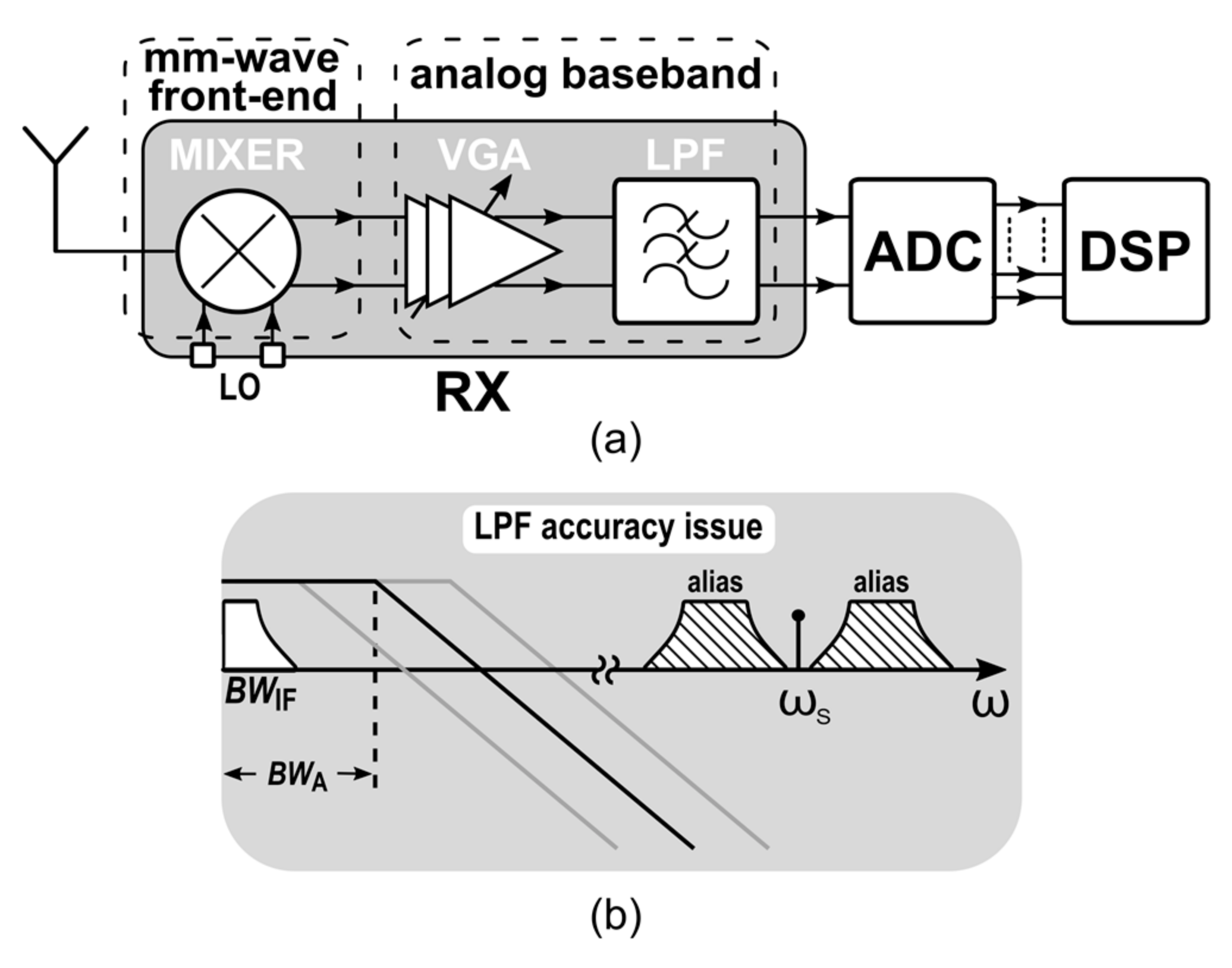


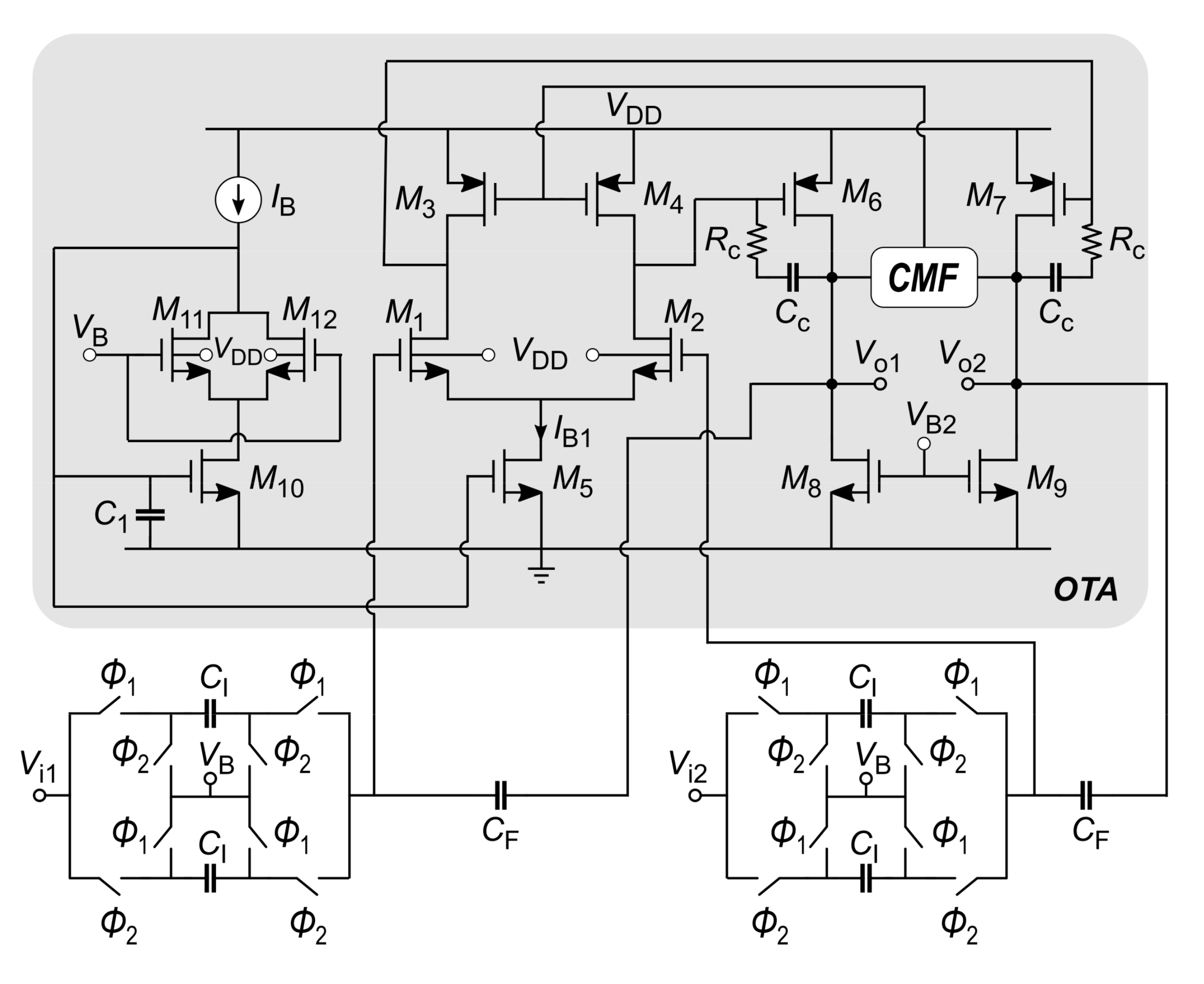
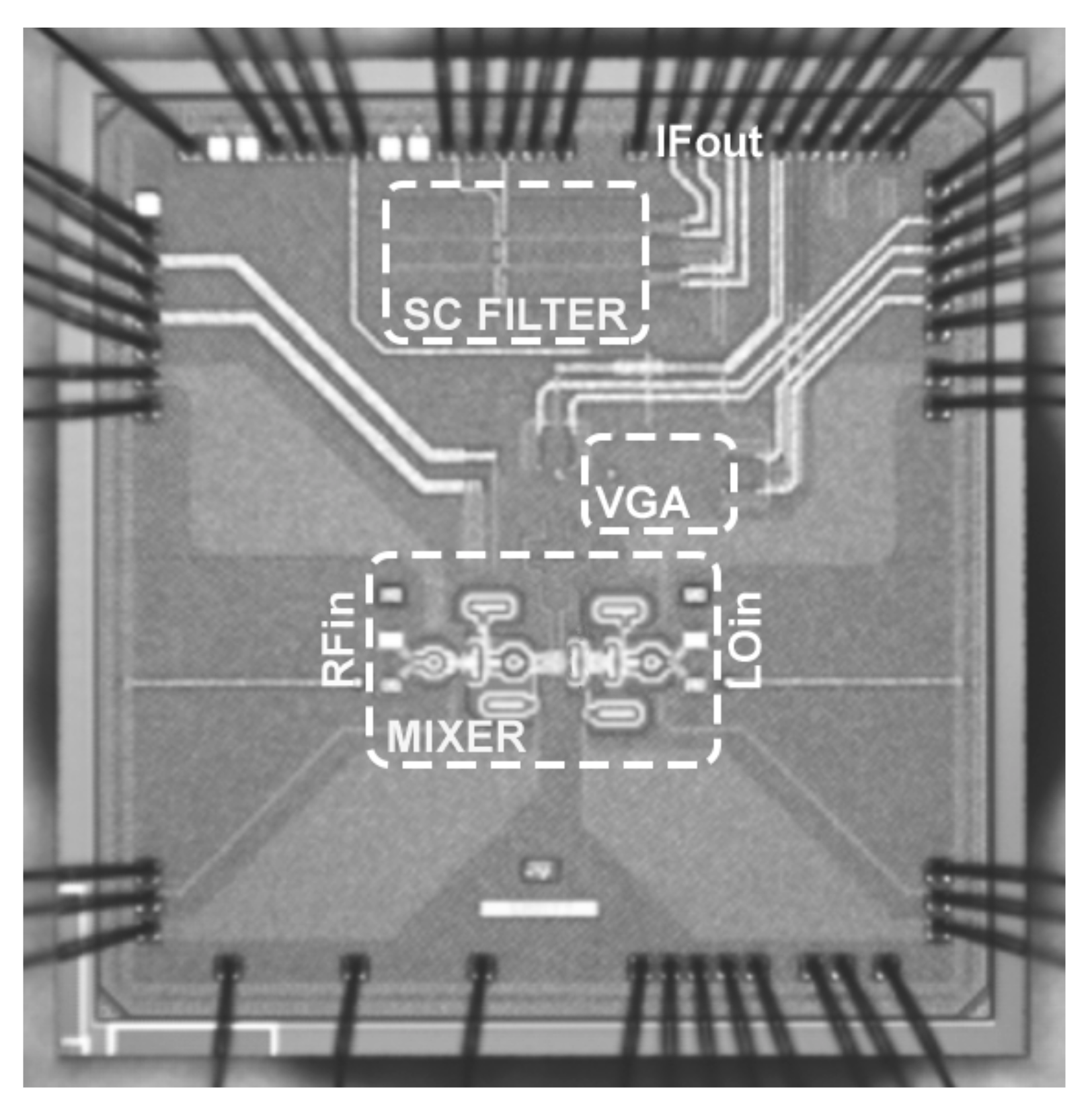
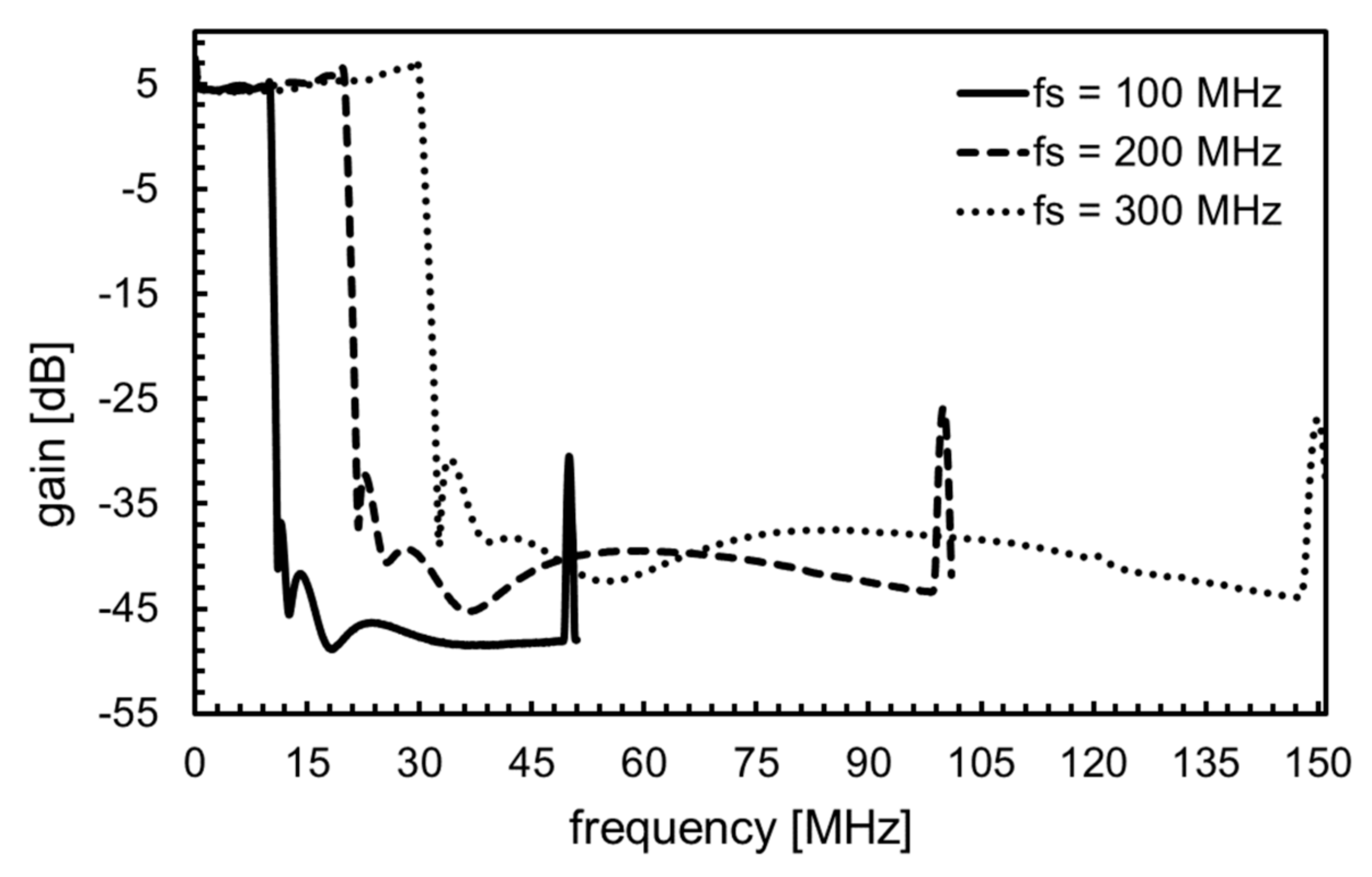
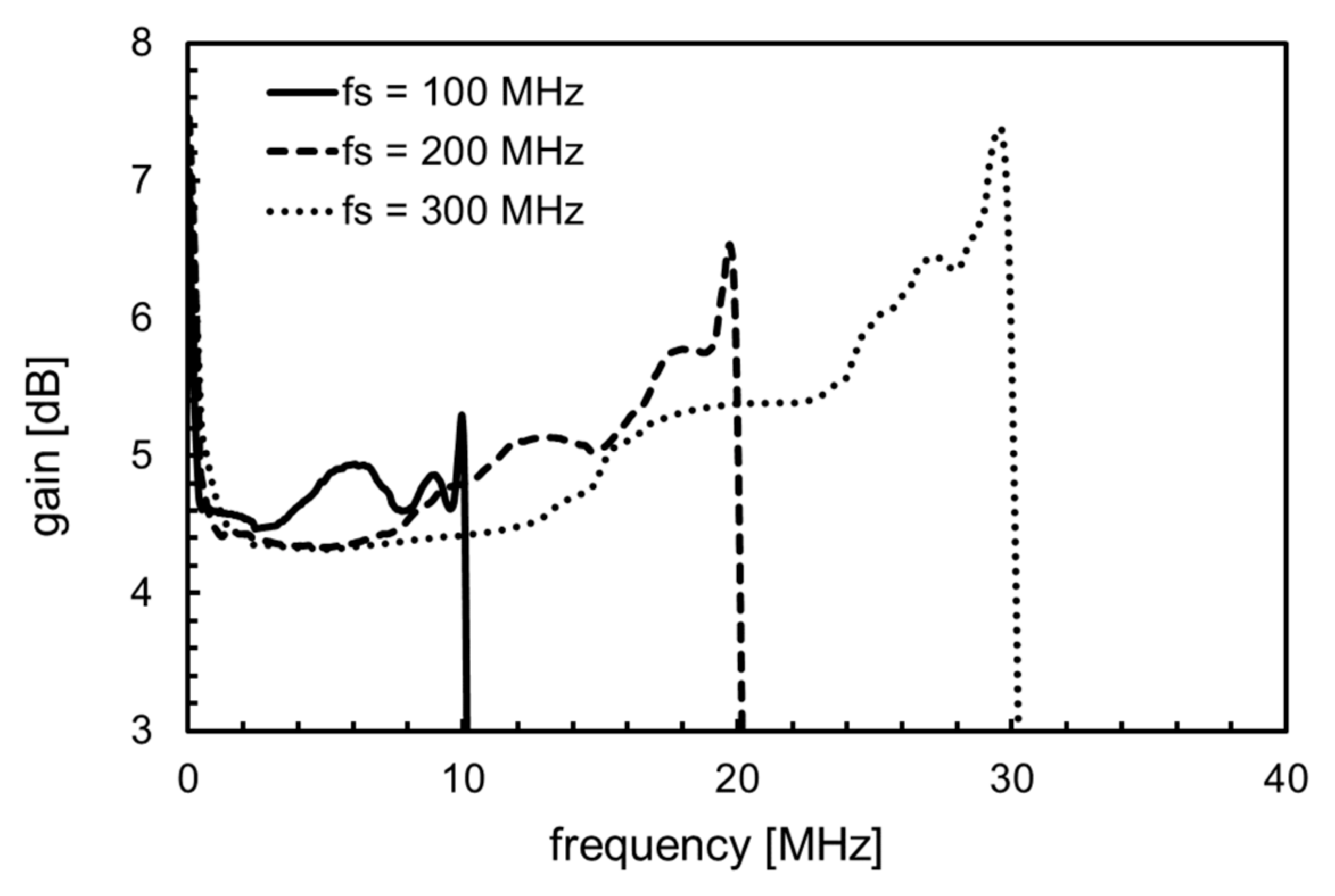
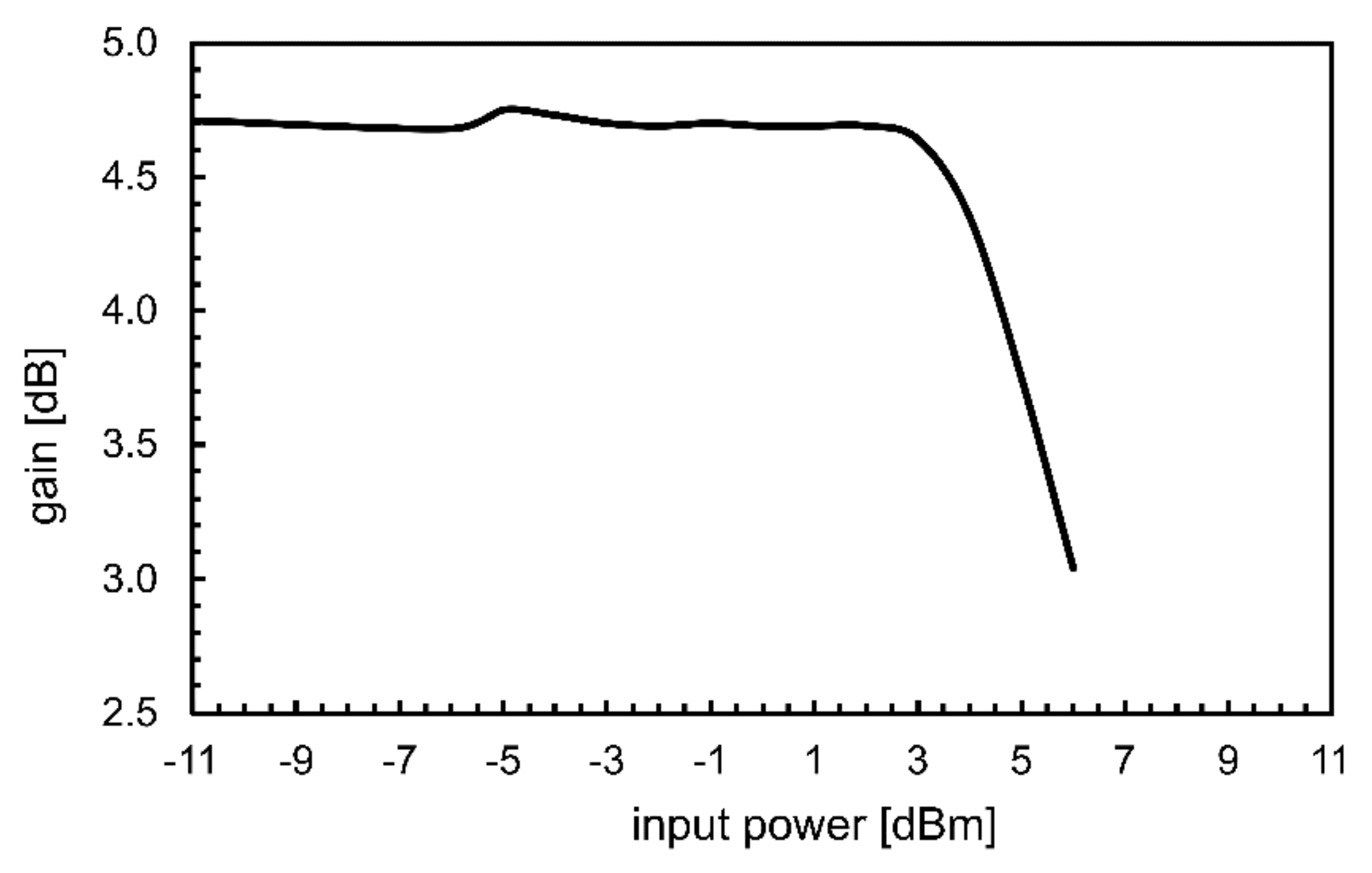
| Component | Size | Component | Size |
|---|---|---|---|
| RS | 50 Ω | C6 | 288.12 pF |
| C1 | 403.23 pF | C7 | 276.80 pF |
| C2 | 77.09 pF | L2 | 854.7 nH |
| C3 | 464.58 pF | L4 | 450.27 nH |
| C4 | 421.98 pF | L6 | 531.72 nH |
| C5 | 376.90 pF | RL | 50 Ω |
| Component | Length [nm] | Width [µm] | Current [µA] |
|---|---|---|---|
| M1–2 | 60 | 21.6 | 10 |
| M3–4 | 160 | 3.6 | 10 |
| M5 | 500 | 105 | 20 |
| M6–7 | 60 | 115.2 | 400 |
| M8–9 | 500 | 204.8 | 400 |
| M10 | 500 | 52.5 | 10 |
| M11–12 | 60 | 10.8 | 5 |
| Parameters | [15] | [16] | [17] | [19] | [24] | [26] | This Work |
|---|---|---|---|---|---|---|---|
| Technology [nm] | 130 | 180 | 180 | 65 | 350 | 65 | 28 |
| Technique | Active RC | Active RC | Gm-C | Active RC | SC | SC-Buffer Biquad. | SC |
| Supply voltage [V] | 0.6 | 1.8 | 1.2 | 1.8 | 1.5 | 1.2 | 1 |
| Order, N | 4 | 4 | 3 | 4 | 5 | 4 | 7 |
| Bandwidth (BW) [MHz] | up to 160 | 0.6–2.15 | 20 | 0.02–16 | 6–8 | 0.5–10 | up to 30 MHz |
| Filter gain [dB] | 0 | 0 | 0 | 0 | 0 | 0 | 5 |
| OIP3 [dBm] | 9.56 | −6.5 | 18 | 21.1 | n.a. | 16.6 | 18.7 * |
| Input noise [nV/] | n.a. | 9–206 | 12 | 44.6 | n.a. | 19.5 | 42 |
| Power (PC) [mW] | 23.77 | 12.6 | 11.1 | 19 | 11 | 2.75 | 9 |
| Area [mm2] | 0.236 | 0.17 | 0.23 | 0.098 | 0.29 | 0.02 | 0.2 |
| FoM [pJ] ** | 4.1 | 6544 | 2.9 | 2.3 | n.a. | 1.5 | 0.6 |
Publisher’s Note: MDPI stays neutral with regard to jurisdictional claims in published maps and institutional affiliations. |
© 2021 by the authors. Licensee MDPI, Basel, Switzerland. This article is an open access article distributed under the terms and conditions of the Creative Commons Attribution (CC BY) license (https://creativecommons.org/licenses/by/4.0/).
Share and Cite
Parisi, A.; Papotto, G.; Ragonese, E.; Palmisano, G. A 1-V 7th-Order SC Low-Pass Filter for 77-GHz Automotive Radar in 28-nm FD-SOI CMOS. Electronics 2021, 10, 1466. https://doi.org/10.3390/electronics10121466
Parisi A, Papotto G, Ragonese E, Palmisano G. A 1-V 7th-Order SC Low-Pass Filter for 77-GHz Automotive Radar in 28-nm FD-SOI CMOS. Electronics. 2021; 10(12):1466. https://doi.org/10.3390/electronics10121466
Chicago/Turabian StyleParisi, Alessandro, Giuseppe Papotto, Egidio Ragonese, and Giuseppe Palmisano. 2021. "A 1-V 7th-Order SC Low-Pass Filter for 77-GHz Automotive Radar in 28-nm FD-SOI CMOS" Electronics 10, no. 12: 1466. https://doi.org/10.3390/electronics10121466







